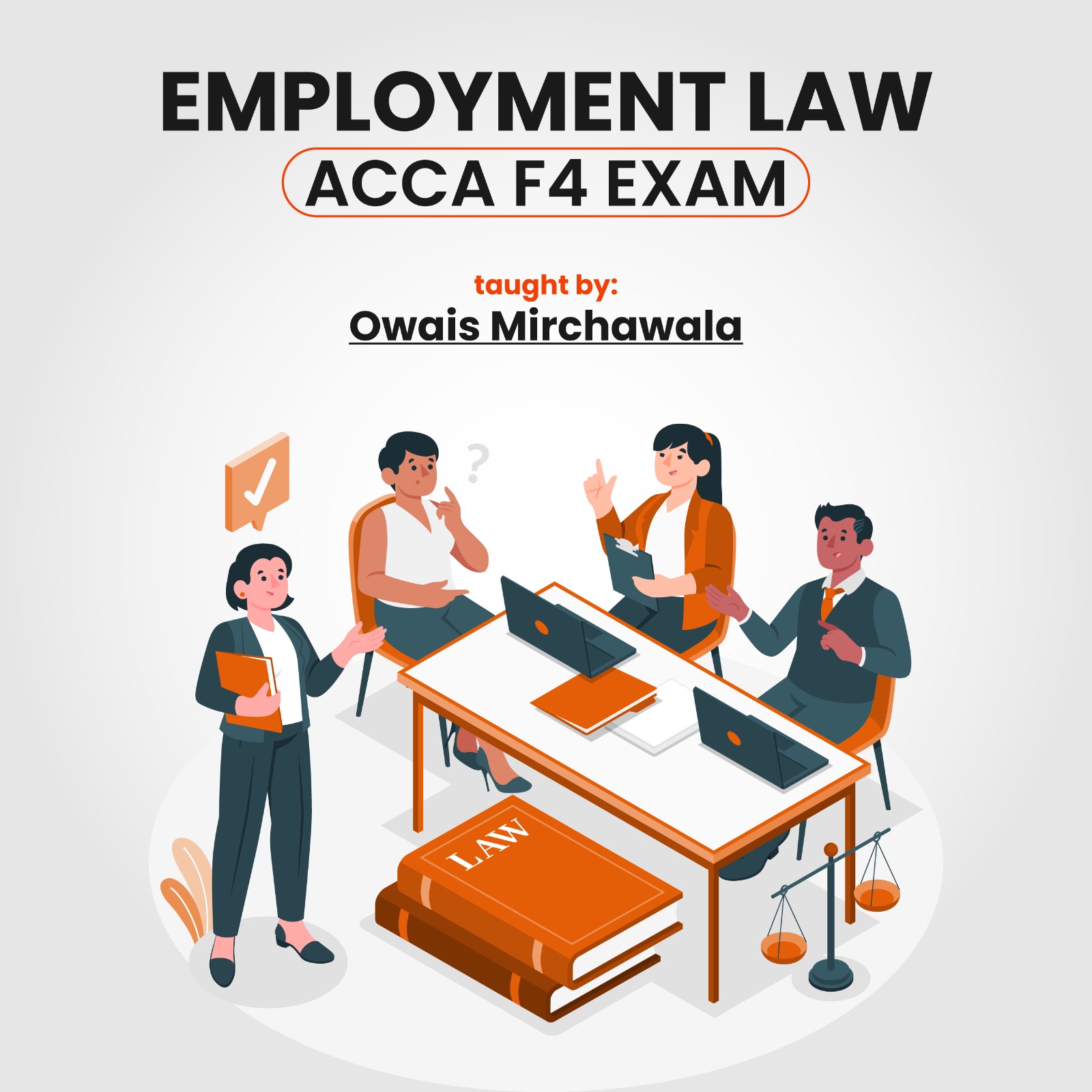EMPLOYMENT LAW
EMPLOYMENT LAW
Contract of service and contract for services
Employment law is a large area of law. It affects all employers: sole traders with employees, partnerships, companies and other organisations that employ people.
The difference between a contract of service and a contract for services
There is an important difference between:
A Contract of Service:
Employment agreements known as contracts of service state that an employee will labour for an employer in exchange for money, such as a wage or salary. A worker with a contract of service is therefore an employee.
A Contract for Services
A contract for services is an arrangement in which two separate parties agree that one will provide the other with services in return for payment. So, an independent contractor, or self-employed person, provides a contract for services to another party.
Contract of employment
Employment Rights Act 1996
This Act defines states the right of an employee to a written statement of particulars of employment specifies a variety of rights of the employee deals with dismissal of employees, and considers when dismissal is unfair or for reasons of redundancy.
Definition of employee
Employee as ‘an individual who has entered into or works under a contract of employment’. The Act uses the term ‘contract of employment’ rather than ‘contract of service’. It also states that a contract of employment means a contract of service or apprenticeship that may be:
- An express agreement or implied, and
- If it is an express agreement, it may be oral or in writing.
Particulars of employment
Employee begins employment, the employer must give the employee a written statement of particulars of employment.
This statement must contain particulars of the following:
- the names of the employer and the employee
- the date that the employment began
- the rate of pay
- the intervals at which remuneration will be paid (weekly, monthly or at other specified intervals)
- hours of work
- entitlements to holiday and holiday pay
- conditions relating to incapacity due to sickness or injury, and sick pay
- pensions arrangements
- length of notice that must be given by the employer and by the employee to terminate the contract of employment
- where the contract of employment is for a fixed term, the date when it is to end
- the employee’s place of work
- the employer’s address.
Duties of an employer
The duties of the employer are as follows:
- To pay reasonable remuneration: This aspect of employment is now largely covered by the minimum wages legislation, but in the absence of an express clause in the contract of employment this duty would be implied.
- To provide a safe system of work: This is covered by the common law duty to take reasonable care of employees, but is also covered by the health and safety at work legislation.
- Duty of mutual co-operation: Both employers and employees are expected to establish reasonable working relations so that both parties behave with a view to achieving a mutually acceptable working relationship.
- Duty to provide work: There is no common law duty for an employer to provide work to the employee. However, such a duty may be implied when a failure to provide work would deprive the employee of benefits expected from the employment. In particular, this implied duty is likely to
Duties of an employee
An employee has certain duties, as follows:
- Duty of mutual co-operation with the employer.
- Duty to obey reasonable and lawful orders.
- Duty of reasonable skill and care. Employees have a common law duty to exercise reasonable skill and care in any activity that they carry out in their role as an employee.
- Fiduciary duty of ‘good faith’, which is a duty to give honest and faithful service. Employees have a duty of honesty to their employer and must account for all money and property that they receive in the course of their employment.
- Cannot delegate. An employee cannot delegate the responsibilities as an employee to a third party.
Unfair dismissal
Unfair dismissal and the Employment Rights Act 1996
The Employment Rights Act states that an employee has a right not to be dismissed unfairly by his employer. An employee has the right to file an appeal with a tribunal if his employer fires him unfairly.
- Statute law unfair dismissal: An employee might choose instead to take action against the employer in common law for wrongful dismissal.
Definition of dismissal
An employee is dismissed by his employer. Dismissal occurs in any of the following situations.
- The employer terminates the contract of employment, with or without notice.
- The employee’s fixed term of employment comes to an end and the employer does not renew it.
- The employee terminates the contract of employment, with or without notice, in circumstances where the employee is justified in terminating the conduct because of the conduct of the employer.
Constructive dismissal
Constructive dismissal occurs when the employer does not formally dismiss the employee by terminating his contract of employment, but acts in such a way that the employee is justified in terminating the employment due to the ‘fault’ of the employer.
Conditions for constructive dismissal
The grounds for claiming constructive dismissal:
- There must be a fundamental breach of the contract of employment by the employer.
- This breach of contract must have caused the employee to leave the job.
- The employee should not delay his resignation for too long; otherwise remaining in the job will be an affirmation of the contract of employment.
- The employee then loses the right to claim constructive dismissal. (In many cases of constructive dismissal, the action of an employer might cause the employee to walk out of the job immediately.)
Summary dismissal
Summary dismissal is when an employer dismisses an employee without notice, often unfairly. It can be justified when the relationship between employer and employee has broken down, and the employee is in serious breach of duty, such as refusing to comply with an order, a serious incident, or extreme carelessness.
Deciding whether dismissal is fair or unfair
If the employee can establish that he has been dismissed, and has not simply walked out of his job, the onus is on the employer to demonstrate that the dismissal was fair. The Employment Rights Act 1996 sets out the circumstances in which dismissal is fair and when it is unfair.
- When it is fair, the employee has no legal claim against the employer.
- When dismissal is unfair, the employee is given statutory protection by the Act.
When dismissal is fair
When an employee alleges unfair dismissal, it is for the employer to show the reason for the dismissal and to demonstrate that the dismissal was fair.
Specifies five situations where a dismissal will be considered ‘fair’, provided that the employer has ‘acted reasonably’:
- The employee did not have the capability or the qualifications to do the work for which he was employed. ‘Capability’ could refer to skill, aptitude, health or any other mental or physical quality (such as height or strength). ‘Qualifications’ refers to an academic, technical or professional qualification.
- The conduct of the employee justified dismissal. In general, any breach of an employee’s contractual duties or any act of gross misconduct will be covered by this ‘fair’ cause for dismissal.
- The employee was made redundant. When an employee is made redundant, he has different rights
under the law on redundancy. - The employee could not remain in the current position without breaking the law.
- Some other substantial reason, where in the circumstances the employer acted reasonably, and his reasons were sufficient to justify dismissal. This is very general, and the court will decide each case on its merits, applying the principle of equity or fairness in reaching a judgement.
If the reason for dismissing the employee is fair, but the employer did not act reasonably, the dismissal will be regarded as unfair by an employment tribunal.
When dismissal will be judged unfair
Whether or not a dismissal is unfair will often depend on circumstances. However, the Employment Rights Act 1996 specifies a number of situations where the court will decide that a dismissal is unfair.
An employee will be regarded as having been unfairly dismissed:
- He has raised issues concerning health and safety at work
- The employee is pregnant, or for a reason connected with the pregnancy of the employee
- The employee is involved in trade union activities or because he is a member of a trade union: however, when individuals are engaged in a strike it is not unfair to dismiss them provided that the employer dismisses them all and does not pick on selected individuals to dismiss (for example, dismissing the leaders of the strike)
- The employee has made a ‘protected disclosure’: the employee has been a ‘whistleblower’, and has reported the employer for engaging in certain activity, such as;
– criminal activity
– a breach of legal obligations
– a breach of health and safety regulations
– activity that is damaging to the environment.
- In order to uphold a statutory right or claim that the employer violated upon the employee’s rights, the employee has brought legal action against the employer. Statutory rights include statutory rights under the Working Time Regulations 1998 and the National minimum Wage Act 1998.
- The employee was made redundant, but other employees working in a similar position and doing the same type of work were not made redundant, and the employer has victimised the employee in selecting him for redundancy.
Remedies for unfair dismissal
After one year’s employment, an employee can make a claim for unfair dismissal to an employment tribunal. Three months after the dismissal, the complaint must be submitted.
If the employee wins his or her case, the tribunal can choose from three remedies. These are:
- Reinstatement
- Re-engagement
- Compensation
Reinstatement:
Reinstatement is a process where an employee is treated as if they had never been dismissed, restoring them to their previous job and conditions. The tribunal will specify the amount of arrears, rights, and compliance deadlines for the employer.
Re-engagement:
Re-engagement involves an employee being offered another job by the employer or associated company, comparable to the one they were dismissed from. The employment tribunal will specify the nature of the re-engagement and remuneration, and may also specify additional benefits.
Compensation:
The employment tribunal may order compensation, including reinstatement or re-engagement, or may decide to pay it without reinstatement or re-engagement, as per ERA 96 (section 118).
Wrongful dismissal as an alternative to a claim for unfair dismissal
Wrongful dismissal can be an alternative to unfair dismissal under the Employment Rights Act 1996. A tribunal typically awards damages, not reinstatement or re-engagement.The sum should be equal to the employee’s wage loss, but to lessen their losses, the employee ought to look for alternative employment.
Redundancy
The purpose of legislation on redundancy
Redundancy is a form of dismissal of employees. Dismissal through redundancy is not unfair, but employees who are made redundant have certain rights. The statute law on redundancy is contained in the Employment Rights Act 1996. The purpose of the legislation is two-sides:
- to encourage employers to consider alternative ways of dealing with employees other than dismissing them, when the work that they do is no longer required
- to give employees who are dismissed for reasons of redundancy the right to a minimum payment, to help them until they can hopefully find another job.
The meaning of redundancy
It states that an employee is dismissed if the employer ceases or intends to cease carrying out the business for which the employee was employed, or if the business’s requirements for the employee’s work have ceased or diminished.
Relocation of place of business
Disagreements may arise between an employer and an employee when the employer proposes to move to another place of business, and the employee refuses to move. The employee might claim that this amounts to redundancy, whereas the employer might argue that the re-location is not a significant distance.
- If the employer offers the employee identical or very similar work in the new location, and the re-location causes no added inconvenience to the employee, the employee cannot claim dismissal for redundancy.
- If the re-location will cause added inconvenience to the employee, the employee can claim dismissal for redundancy, provided that there is no ‘mobility clause’ in his contract of employment. A mobility clause is a clause stating that the employee may be expected to move if required by the employer.
Resignation or redundancy?
Resignation or redundancy is generally undisputed when an employee resigns due to an unreasonable demand from the employer, such as relocation or reorganization. In such cases, the employee must prove they did not voluntarily resign, and the employer must prove it was not due to redundancy or unfair dismissal. When the employer cannot demonstrate that the dismissal was voluntary, a dispute results.
Offer of alternative employment
An employee loses the right to claim redundancy payments if, before the end of his employment:
the employer offers suitable alternative employment, and
the employee unreasonably refuses the offer.
The right to claim a redundancy payment
To claim a redundancy payment, an employee must have been in the employer’s employment for at least two years. This differs from the right to claim unfair dismissal, which requires one year of continuous employment. The right to claim a redundancy payment is limited and can be lost within six months of receiving a notice, agreeing to the payment, submitting a claim, referring a dispute to an employment tribunal, or a claim for unfair dismissal.
The amount of the redundancy payment
The Employment Rights Act 1996 outlines the minimum redundancy payment for employees aged 41 or over, those aged 22 or over but below 41, and those not falling within these categories. The rules were slightly amended after October 2006. Employees are entitled to 1½ weeks’ pay for each year of employment.
The redundancy process
If an employer plans to make over 20 employees redundant and has a trade union representing them, they must consult with the union or alternative representative body. The redundancy procedure should include providing advance notice, selecting employees based on fair grounds, considering alternative employment, and full consultation with the employee and their representatives. Employment tribunals expect employers to follow these guidelines.
Written by: Mahnoor Maqbool bright student of Mirchawala’s Hub Of Accountancy












[…] LAW Contract of service and contract for services Employment Read more February 3, […]
[…] Study Hub: The Perfect Learning Solution to Be Exam-Ready Read more February 3, […]
Comments are closed.